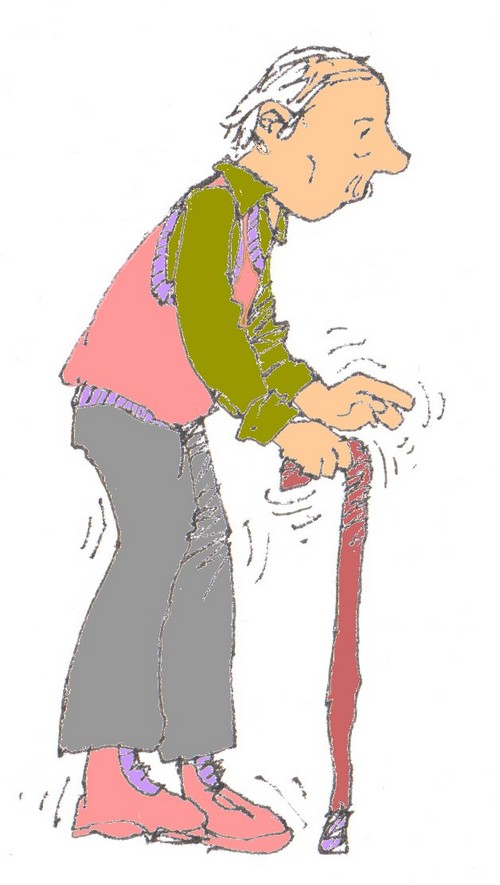EXERCISE AND PARKINSON’S DISEASE
Even though I am fanatical about the benefits of regular exercise I know I still have much to learn about the full range of what it can achieve. I am grateful to my friend and colleague, Karen, for pointing out to me the effects of exercise both for preventing and for managing patients with Parkinson’s disease (PD).
What is Parkinson’s disease?
Parkinson’s disease was originally described as “the shaking palsy” by James Parkinson in 1817. The main features of PD are stiffness, difficulty with movements and a characteristic so-called pill rolling tremor. Affected individuals have increasing difficulty with motor functions such as walking, writing and some social functions such as holding a tea cup. The condition progresses with age and may in time completely incapacitate the sufferer – and can also lead to dementia.
PD affects about 1% of people over the age of 65, becoming commoner with increasing age. Currently there about 150,000 people in the UK with the disease – a not inconsiderable burden.
Exercise and prevention of PD
A meta-analysis (combined results of many studies – in this case involving half a million subjects. See glossary) has shown that those who take most exercise reduce their risk of PD by about one fifth. Even more convincing, another study has found that those with high levels of physical fitness have one quarter the risk of developing PD compared with the least fit.
Exercise and treatment of PD
Intensive exercise programmes have been shown to improve mobility and reduce disability in PD patients. A 2010 meta-analysis found that exercise, mainly physiotherapy, improves physical functioning and quality of life, leg strength, balance and walking in Parkinson’s disease patients. Other studies have shown better flexibility, aerobic resistance, gait speed, handgrip strength and balance in physically trained PD patients when compared with a control group. It has been suggested that resistance training can provide a neuroprotective effect.
How might these findings be applied to the average PD patient at home?
The Lancet has recently published the results of a trial from the Netherlands1. 130 home-based early stage PD patients were randomised to either aerobic exercise done on a stationary home-trainer (aerobic intervention group) or stretching (active control group). Exercise was undertaken as 30–45 min training three times per week for 6 months. At the end of this period, both groups were reassessed for (and many apologies for this mouthful) Movement Disorders Society—Unified Parkinson’s Disease Rating Scale (MDS-UPDRS) motor section , tested when off medication. This rather esoteric sounding assessment is designed to test the degree of muscle involvement in PD patients. The results showed a considerable advantage to the aerobic training group over the controls.
The implications
The main approach to the treatment of PD has been medication – which can lessen some of the stiffness of the condition but which has little effect on its progression and which also produces a variety of adverse effects. It is too soon to know whether exercise alters the rate of progression of PD, but it does reduce the symptoms with little in the way of ill effects. Worth a try.
- doi.org/10.1016/S1474-4422(19)30285-6
Subscribe to the blog
Categories
- Accelerometer
- Alzheimer's disease
- Blood pressure
- BMI
- Cancer
- Complications
- Coronary disease
- Cycling
- Dementia
- Diabetes
- Events
- Evidence
- Exercise promotion
- Frailty
- Healthspan
- Hearty News
- Hypertension
- Ill effects
- Infections
- Lifespan
- Lipids
- Lung disease
- Mental health
- Mental health
- Muscles
- Obesity
- Osteoporosis
- Oxygen uptake
- Parkinson's Disease
- Physical activity
- Physical fitness
- Pregnancy
- Running
- Sedentary behaviour
- Strength training
- Stroke
- Uncategorized
- Walking



What type of exercises do you suggest that would easiest to start with?
Thank you June
The evidence on this is incomplete.
If you are thinking of prevention just do the exercise you enjoy most.
For treating Parkinson’s disease common sense would suggest exercising as many muscles as possible. Circuit type training in a gym would be suitable. If you are unaccustomed to exercise, discuss the programme with an exercise supervisor. In some areas GPs can do “exercise prescriptions”, sending you to the local Sports Centre.
If you don’t like gyms, walking is an excellent exercise – try building up to half an hour daily most days of the week.